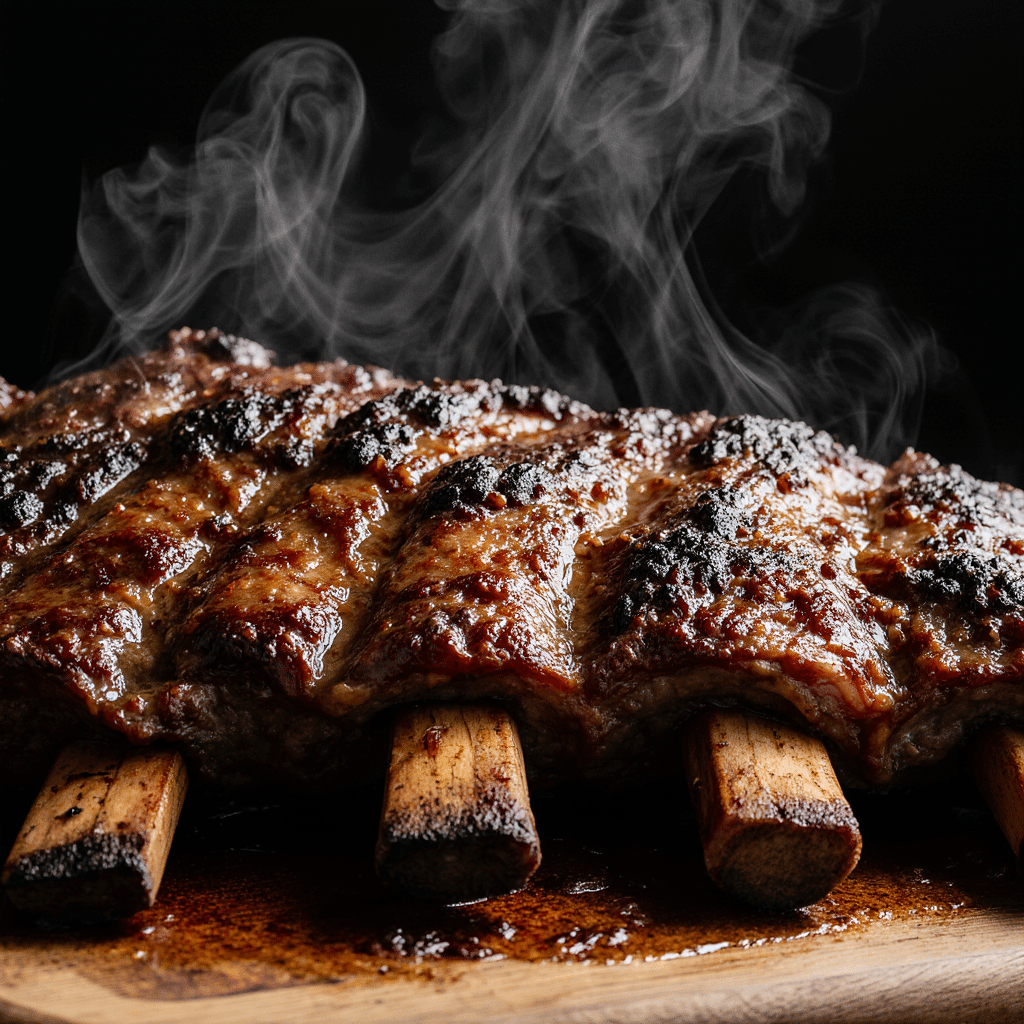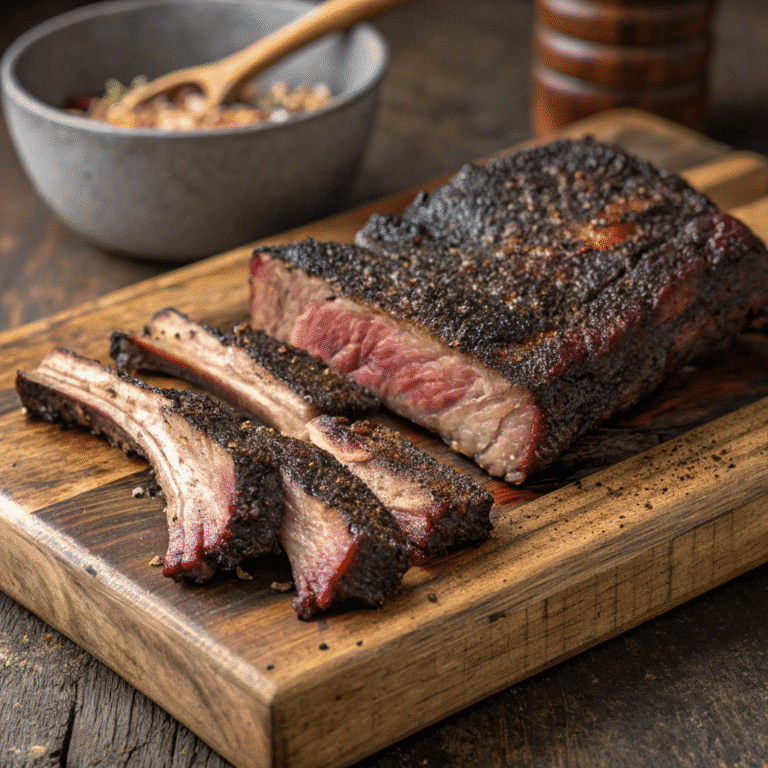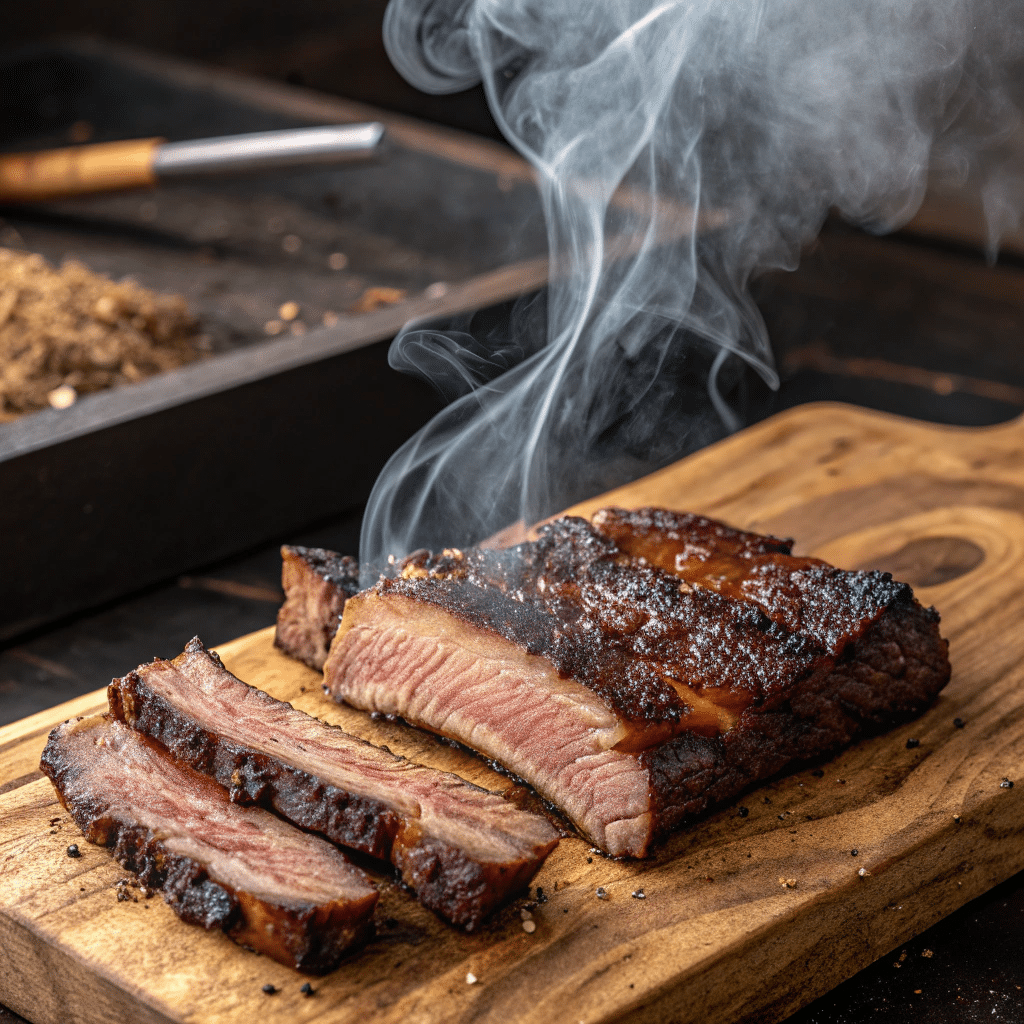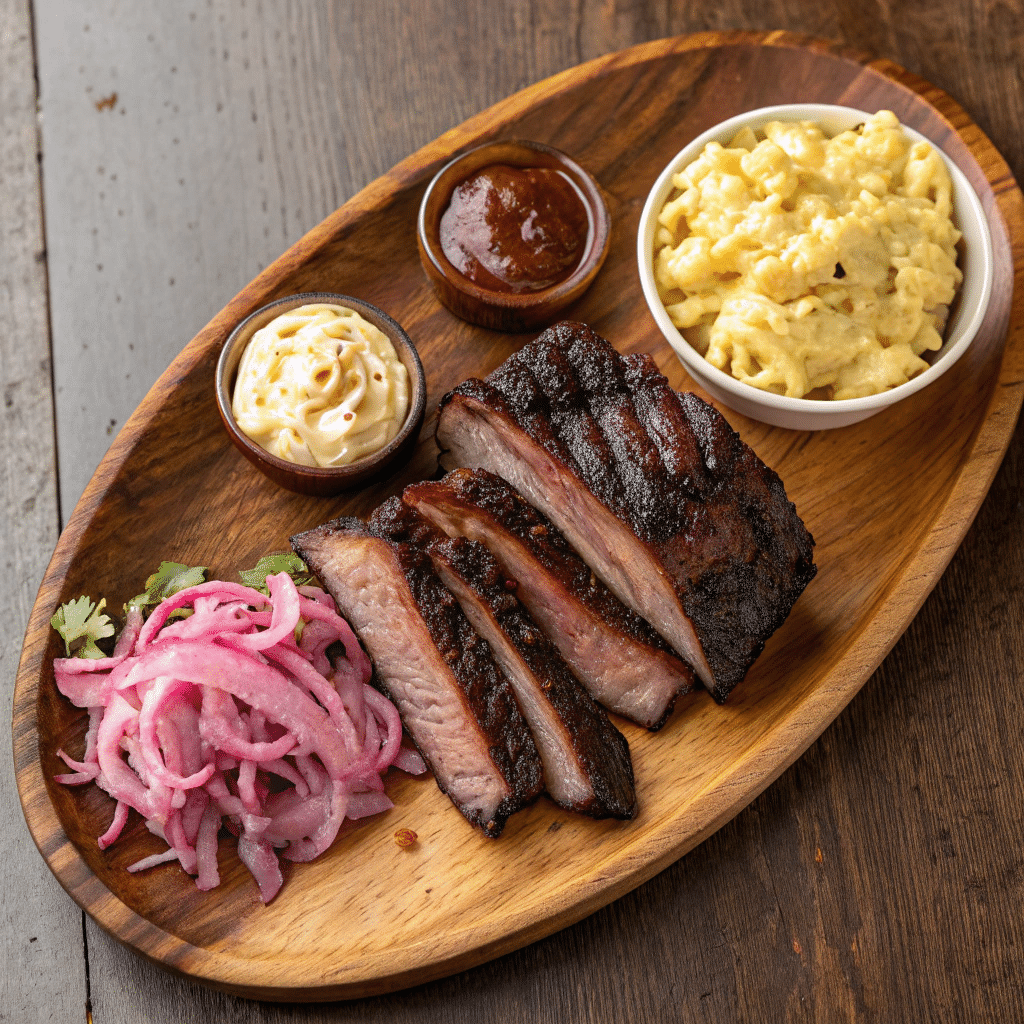There’s nothing quite like the deep, smoky flavor and fall-off-the-bone tenderness of perfectly smoked beef short ribs. Whether you’re an experienced backyard pitmaster or firing up your smoker for the first time, this guide will walk you through every juicy detail. From choosing the right cut of ribs to achieving that signature Texas-style bark, we’re covering all the bases to help you master smoked beef short ribs like a pro.

In this comprehensive guide, you’ll learn the exact smoking temperatures, how long it takes to smoke short ribs properly, and what makes smoked ribs different from your typical BBQ ribs. We’ll also go deep into wood selection, trimming, rubs, and how to troubleshoot common mistakes so your beef ribs turn out mouthwateringly tender every single time.
Print
Smoked Beef Short Ribs (Texas-Style)
Juicy, fall-off-the-bone smoked beef short ribs prepared Texas-style with a simple rub and low-and-slow smoker method. Perfect for backyard BBQs.
- Total Time: 7 hours
- Yield: 6 servings 1x
Ingredients
2 full racks of beef short ribs (3–4 lbs each, bone-in)
2 tbsp coarse black pepper
1 tbsp kosher salt
1 tsp garlic powder (optional)
Post oak or hickory wood chunks
Butcher paper or foil (for wrapping)
Optional: 1 tsp smoked paprika for deeper color
Instructions
Trim ribs of excess fat and silver skin if needed.
Combine black pepper, salt, and any optional spices. Rub generously over all sides of ribs.
Let ribs rest uncovered in the fridge for 2–4 hours. Bring to room temp before smoking.
Preheat smoker to 250°F. Use post oak or hickory for best flavor.
Place ribs bone-side down. Smoke unwrapped for 4–5 hours until a dark bark forms.
Wrap ribs in butcher paper once internal temp hits 165°F.
Continue smoking until ribs reach 200–205°F and probe tender.
Remove from smoker and let rest wrapped for 1 hour before slicing.
Serve with your favorite BBQ sides.
Notes
Always cook to internal temperature, not time.
Avoid opening the smoker too often—it affects heat retention.
Use a water pan inside the smoker to stabilize temps and keep moisture in.
Resting is crucial for tender, juicy results.
- Prep Time: 15 minutes
- Cook Time: 6 hours
- Category: Dinner, BBQ
- Method: Smoking
- Cuisine: American, Texas BBQ
- Diet: Gluten Free
Nutrition
- Calories: 520
- Fat: 40g
- Protein: 38g
Looking for inspiration? Try this bold smoked mac and cheese recipe to pair with your ribs—creamy, smoky, and the perfect complement to your backyard barbecue.
Table of Contents
What Are Smoked Beef Short Ribs?
Understanding the Cut: Beef Short Ribs Explained
Smoked beef short ribs come from the plate or chuck area of the cow, known for thick, meaty bones and deep marbling. Unlike pork ribs, these are rich, beefy, and full of connective tissue that melts during a long, slow cook. That’s why they’re ideal for low-and-slow smoking.
There are two main types of short ribs:
- English-cut ribs, where the meat sits atop the bone.
- Flanken-cut ribs, sliced across the bone for thinner, faster-cooking ribs.
For smoking, English-cut beef short ribs are the go-to. They’re thick, meaty, and offer more surface area for smoke and rub to penetrate.
Why Short Ribs Are Perfect for Smoking
Because of their rich fat marbling and sturdy connective tissue, smoked beef short ribs excel when cooked slowly over indirect heat. The smoke penetrates deep into the muscle fibers, transforming collagen into gelatin, resulting in that irresistibly tender, melt-in-your-mouth texture everyone craves.
When done right, you’ll end up with a thick, flavorful bark on the outside and juicy, smoky meat inside. That contrast is what makes smoked short ribs such a prized cut in BBQ culture.
Different Styles: English vs. Flanken Cut
Let’s break it down:
| Cut Type | Appearance | Smoking Time | Flavor Absorption |
|---|---|---|---|
| English | 3–5” bone-in blocks | Long (6+ hrs) | Deep, rich, smoky flavor |
| Flanken | Thin cross-sections | Quick (1–2 hrs) | Lighter smoke profile |
English-style is your best bet when aiming for that authentic smoked beef short ribs experience, especially if you’re going Texas-style.
Choosing the Right Ribs for Smoking
How to Select High-Quality Short Ribs
When it comes to smoked beef short ribs, quality starts at the butcher counter. Look for ribs that are:
- Generously thick and packed with meat, boasting a minimum of two inches of flesh sitting atop the bone.
- Well-marbled, as fat enhances flavor and helps keep the ribs juicy during long smoking sessions.
- Uniform in size, so they cook evenly.
Request “plate short ribs” or “beef chuck short ribs” from your butcher, as these cuts are usually the meatiest and ideal for smoking.
Prime vs. Choice: What’s the Difference?
Chances are, you’ve come across beef marked as USDA Prime or USDA Choice. Here’s what that means for your ribs:
| Grade | Marbling | Price | Smoking Result |
|---|---|---|---|
| Prime | Highest | $$$$ | Extremely tender, juicy |
| Choice | Moderate | $$$ | Still flavorful, slightly less tender |
If you’re aiming for top-notch quality, prime-grade ribs are the way to go. However, choice-grade beef also smokes beautifully—just keep a close eye on your temperature and cooking time to get the best results.
Bone-in or Boneless: What Works Best for Smoking?
For smoked beef short ribs, always go bone-in. The bones lock in moisture, boost the flavor, and serve as a natural barrier against heat. Boneless short ribs, while convenient, are more prone to drying out in the smoker.
Plus, let’s be honest—there’s something primal and satisfying about tearing into a juicy, bone-in rib.
Don’t miss our smoked cream cheese recipe for a savory appetizer to pair with your rib night.
Prepping Smoked Beef Short Ribs Like a Pitmaster
Trimming the Fat: Do You Need to?
Prior to smoking, check your short ribs for any surplus fat. While some fat is good—it bastes the meat and boosts flavor—too much can block smoke and lead to chewy bites. Trim off any thick, hard fat caps, but leave a thin layer for moisture and richness.
Dry Rub or Marinade? Best Flavoring Methods
For smoked beef short ribs, dry rubs win every time. Marinades often struggle to cling to and fully soak into the dense, thick meat.
Here’s a basic dry rub to start with:
- 2 tbsp coarse black pepper
- 1 tbsp kosher salt
- 1 tsp garlic powder
- 1 tsp smoked paprika
Rub it in generously and let the ribs sit at least 2–4 hours, or overnight for bold flavor.
How Long Should You Let Ribs Sit Before Smoking?
Once rubbed, let the ribs rest uncovered in the fridge for several hours. This creates a tacky surface—called the pellicle—which helps the smoke stick better. Just bring them to room temp before placing them in the smoker to avoid a sudden temperature shock.
Check out this bold recipe for smoked mac and cheese—a perfect side while your ribs rest and smoke.
How to Smoke Beef Short Ribs Texas-Style
Traditional Texas-Style Approach Explained
When you hear Texas-style smoked beef short ribs, think simple, bold, and bark-heavy. True to Lone Star traditions, the focus is on the meat and the smoke—no sugary sauces or heavy marinades. The method uses:

- Simple rub: Just salt and pepper (2:1 ratio)
- Post oak wood: For deep, earthy smoke
- Low-and-slow smoking: Between 225°F to 250°F
- Hold off on wrapping until the stall to develop a rich, robust bark.
You don’t need to get fancy. Let the meat, fire, and smoke do the talking.
Best Wood Types for Authentic Texas Flavor
Texas BBQ lovers swear by post oak, but other hardwoods work too. Here’s a quick guide:
| Wood Type | Flavor Profile | Best Use |
|---|---|---|
| Post Oak | Mild, smoky, balanced | Texas-style ribs |
| Hickory | Strong, bold, bacon-like | Hearty smoke flavor |
| Pecan | Mildly sweet, nutty | Softer smoke notes |
| Mesquite | Sharp, intense | Use sparingly |
Avoid fruit woods like apple or cherry—they’re too light for the bold flavor of beef ribs.
Smoking Times and Tips for Texas-Style Short Ribs
Here’s the breakdown of how to smoked beef short ribs the Texas way:
- Preheat smoker to 250°F
- Place ribs bone-side down, fat side up
- Keep the ribs unwrapped in the smoker for 4–5 hours, allowing the bark to fully form.
- Once the internal temperature reaches about 165°F, wrap the ribs tightly in butcher paper.
- Continue smoking until 200°F–205°F internal temp
- Rest ribs, wrapped, for 1 hour before slicing
That’s how pitmasters do it. Simple, no shortcuts, just time and technique.
What Temperature Should Smoked Beef Short Ribs Be Cooked To?
Ideal Internal Temperature for Tender Ribs
To get smoked beef short ribs to that buttery, fall-apart stage, aim for an internal temperature between 200°F and 205°F. That’s the sweet spot where the connective tissue (collagen) fully breaks down into gelatin, giving you that tender, juicy bite.
Anything lower, and your ribs will be chewy. Anything higher, and you risk drying them out—even with all that marbling.
How to Use a Meat Thermometer Correctly
Don’t eyeball it—use a digital meat thermometer for accurate results. Here’s how:
- Place the probe into the meat’s thickest section, steering clear of the bone.
- Check temps periodically after the 4-hour mark.
- Look for probe tenderness—it should slide in like butter once done.
Pro tip: A second probe to monitor ambient smoker temp helps keep everything steady throughout the cook.
When to Wrap Ribs in Foil and Why
During smoking, beef ribs will hit the stall—a point where the internal temp plateaus due to moisture evaporating from the surface. This usually happens around 160°F to 170°F.
How to get through the stall while keeping your meat juicy:
- Cover the ribs with uncoated butcher paper to preserve the bark—this is the preferred method.
- Or use foil (traps more moisture but softens bark)
Wrapping helps retain heat, shortens cook time, and keeps the meat juicy.
How Long to Smoke Beef Short Ribs in a Smoker
Understanding Time vs. Temperature Smoking
The #1 rule in barbecue? Cook your smoked beef short ribs to temperature, not time. While time gives you a starting point, the real goal is hitting that sweet internal temp for perfect tenderness.
Typically, smoked beef short ribs need 6 to 8 hours of low-and-slow cooking. Begin unwrapped to shape the bark, then wrap to complete. Use a meat thermometer to monitor progress—don’t trust the clock alone.
Low-and-Slow: The 3-2-1 Method Explained
Though the 3-2-1 method is a go-to for pork, it can also serve as a solid blueprint for cooking beef ribs:
- Allow your smoked beef short ribs to soak in rich smoke and build a bold, flavorful bark.
- 2 hours wrapped: Trap in moisture using butcher paper
- 1 hour resting: Let the ribs reabsorb juices before slicing
This method offers structure, but always adapt it based on thickness and smoker type. For beef, the final result depends more on internal temperature than fixed hours.
Smoking Chart for Smoked Beef Short Ribs by Weight
Need a rough guide? Here’s a chart tailored to help you plan your cook:
| Rib Weight (Per Rack) | Estimated Time (at 250°F) | Internal Temp Goal |
|---|---|---|
| 2–3 lbs | 6 hours | 200–205°F |
| 3–4 lbs | 7 hours | 200–205°F |
| 4+ lbs | 8+ hours | 200–205°F |
Remember: Thicker smoked beef short ribs take longer to cook—and stall longer too. Patience pays off.
Looking for inspiration? Try our smoked mac and cheese to serve alongside your short ribs for the ultimate BBQ pairing.
Smoked Short Ribs vs. Regular BBQ Ribs
Flavor Profile Comparison
When comparing smoked beef short ribs to regular BBQ ribs (usually pork), the most noticeable difference is flavor intensity.
- Smoked beef short ribs deliver a bold, deep, beefy flavor that pairs beautifully with oak or hickory smoke.
- Pork ribs—like baby back or spare ribs—offer a sweeter, lighter taste and often rely more on sauces for flavor.
Texas-style smoked ribs typically skip the sauce, relying on seasoning and smoke alone to build layers of taste. That’s why beef short ribs shine in BBQ culture—they don’t need much dressing up.
Texture and Meatiness Differences
Let’s talk meat. Beef short ribs boast more heft and flavor than pork ribs—just one can tip the scales at over a pound, whereas an entire rack of pork ribs might still leave you wanting more.
Here’s a quick comparison:
| Type of Rib | Meatiness | Texture | Portion Size |
|---|---|---|---|
| Smoked Beef Short Ribs | Thick, juicy | Dense, tender | 1 rib per person |
| Pork Baby Back Ribs | Leaner | Softer, more delicate | 3–4 ribs per person |
Beef short ribs also contain more connective tissue, making them perfect for low-and-slow smoking that turns tough collagen into melt-in-your-mouth gelatin.
Cooking Technique Differences Between the Two
The smoking process differs too:
- Smoked beef short ribs need 6–8 hours at 250°F, often unwrapped to develop a crusty bark before wrapping and finishing.
- Pork ribs (especially baby backs) can be cooked quicker—often with the 3-2-1 method and more generous use of foil or sauce.
Another major difference? Pork ribs are usually glazed with sweet BBQ sauces, while beef short ribs are often served dry or with minimal sauce—especially in Texas-style BBQ.
If you’re after something smoky and rich, beef short ribs are the king of the pit.
Discover great ideas like our smoked cream cheese recipe to complement either style of rib with a creamy, smoky dip.
Serving and Pairing Distinctive Smoked Beef Short Ribs
Best Side Dishes for Smoked Ribs

When you pull those smoked beef short ribs off the smoker, you want sides that complement—not overpower—their bold flavor. Here are some must-try BBQ sides that hit the mark:
- Smoked mac and cheese: Rich and creamy, it offers a distinctive complement to smoky meat.
- Potato salad: A cool, tangy contrast to warm ribs
- Coleslaw: Crunchy and refreshing, great for balancing fat
- Cornbread: Slightly sweet, adds texture and comfort
- Baked beans: Smoky and sweet, they echo the ribs’ flavor profile
If you’re going all-out, build a platter with multiple textures—crispy, creamy, and fresh—to highlight your perfectly smoked ribs.
Sauces or No Sauce? Texas-Style Traditions
In Texas-style BBQ, it’s common to serve smoked beef short ribs without sauce. The focus is on the meat and the bark—flavor derived solely from smoke, fat, and rub.
However, if you do want a sauce, stick to something bold and beef-friendly:
- Peppery vinegar-based sauces
- Brisket-style mop sauce
- Lightly sweet molasses sauces (used sparingly)
Always serve the sauce on the side. Let guests dip or drizzle as they like—never drown these ribs.
How to Carve and Plate Like a Pro
Serving your smoked beef short ribs should be as impressive as cooking them. Follow these steps:
- Let the ribs relax, wrapped in butcher paper, for 30 to 60 minutes before carving into them. This allows juices to redistribute.
- Slice between the bones, using a long, sharp knife. The meat should pull away easily.
- Plate individually or as a platter. Use a wooden board or cast-iron tray for rustic appeal.
Want a showstopper? Arrange the ribs on a cutting board, encircled by vibrant accompaniments like tangy pickled red onions, smoky charred corn, and a sprinkle of flaky finishing salt or a scattering of fresh herbs for a bold, eye-catching presentation.
Check out our smoked sausage skillet for another easy-to-prepare crowd-pleaser to serve with your BBQ meal.
Troubleshooting Common Smoking Mistakes
Dry or Tough Ribs: What Went Wrong?
If your smoked beef short ribs came out dry or chewy, don’t worry—it’s fixable next time. The usual culprits are:
- Not reaching the right internal temp (should be 200–205°F)
- Not enough marbling in the meat
- Insufficient resting time after smoking
To avoid this, always cook to temp, not time, and choose well-marbled, bone-in short ribs.
Too Smoky or Bitter? Fixing Flavor Issues
Over-smoking or using strong wood like mesquite can overpower your ribs. Also, white, billowy smoke often signals dirty combustion—aim for thin, blue smoke.
Keep vents open, burn clean fuel, and avoid constantly opening the smoker lid.
Fire Management and Temperature Control Tips
Even the finest ribs can be wrecked by rogue heat or sudden flare-ups. Follow these tips:
- Use a digital thermometer to monitor both meat and smoker temps
- Stick to 250°F for low-and-slow consistency
- Keep water pans inside the smoker to stabilize heat and add moisture
When in doubt, less fussing equals better results.
Frequently Asked Questions (FAQ)
How do you smoke beef short ribs Texas-style?
Texas-style smoked beef short ribs are all about keeping it simple and letting the smoke do the talking. Start by trimming the ribs and seasoning them generously with a 2:1 mix of coarse black pepper and kosher salt. Preheat your smoker to 250°F and use post oak wood for that signature Texas flavor. Smoke the ribs bone-side down, unwrapped, until the bark sets—usually around 4–5 hours. When the internal temperature reaches approximately 165°F, wrap the meat in butcher paper and keep smoking until it climbs to between 200 and 205°F. Let them rest for an hour before slicing.
What temperature should smoked beef short ribs be cooked to?
The ideal internal temperature for smoked beef short ribs is 200°F to 205°F. This range ensures the connective tissue has fully broken down, making the ribs tender and juicy. Always use a meat thermometer to check for doneness—probe tenderness is just as important as temperature.
How long does it take to smoke beef short ribs in a smoker?
It typically takes 6 to 8 hours to smoke beef short ribs at 250°F. The time may vary depending on the size and thickness of the ribs, as well as smoker performance. Smoke unwrapped for the first half of the cook to develop bark, then wrap in butcher paper and finish cooking to target temp.
What is the difference between smoked short ribs and regular BBQ ribs?
The main difference lies in the type of meat and cooking style. Smoked short ribs come from beef and are thicker, richer, and more marbled. Regular BBQ ribs usually refer to pork ribs, which are leaner and sweeter. Beef ribs are often smoked with minimal seasoning and no sauce (Texas-style), while pork ribs are commonly glazed with sweet BBQ sauce and cooked faster.
Conclusion: Mastering Smoked Beef Short Ribs at Home
There’s a reason smoked beef short ribs are beloved in BBQ circles—they offer a rich, smoky flavor and juicy tenderness that’s hard to match. With the right cut, a solid rub, and a little patience, you can turn this humble cut into a barbecue showstopper.
Whether you’re going Texas-style with nothing but salt, pepper, and oak smoke, or experimenting with sauces and sides, the key is low and slow. Focus on the details—trimming, temp control, wrapping, and resting—and your ribs will reward you with bite-after-bite satisfaction.
Don’t miss our smoked deviled eggs for a crowd-pleasing appetizer that pairs perfectly with ribs.
Follow us on Facebook at how to cooking recipes for daily recipe inspiration and kitchen tips.
